Meat, salad, fish, cake - these and many other dishes are usually eaten with a fork . It serves for many functions - piercing and separating food, mixing, transferring portions. There are 35 varieties of the device - short and long, with two, three and four teeth. How to find suitable options for your kitchen among this variety? Let's look at the main types of table accessories and the etiquette rules for their use.
Types of cutlery
The table set for an official reception amazes with the abundance of forks - a special tool is served for each type of food. They differ in length, handle shape, number of teeth and distance between them. The simpler the shape of the tool, the more applications it finds.
Four-prong dining and serving models are commonly used in homes and are suitable for most hot dishes. According to the rules of etiquette, knives of a special shape are paired with them. Spaghetti is eaten with both a fork and a spoon.
There are also devices designed for individual dishes - fondue, cocktail salads, oysters. They are distinguished by a special shape of the handle or teeth, convenient for consuming specific products.
Dining
In every kitchen you can find a universal eating utensil with four prongs and a slightly curved base. Its length is 18-23 cm. In fine restaurants, such devices are not served for dinner, as they look disproportionately small compared to restaurant plates. The dining accessory is suitable for any hot dishes, including meat, vegetables, pasta, fish.
Fish
The product differs from the standard table model by the presence of a thickened tooth on the left. It is used to remove fish bones. In restaurants, the tool is served with a fish knife. If you want to pleasantly surprise your guests, you can offer these forks to a fish dish on the holiday table. But when serving boneless fillets, it is more convenient to use regular dinnerware.
Snack bar
It is a smaller version of the dining model, 17-18 cm long. When serving in a restaurant, it is laid out third in order after the dining and fish cutlery. As the name suggests, it is used for cold appetizers such as rolls, stuffed eggs, and pickled vegetables. It is also served for breakfast, consisting of omelettes, cheesecakes, and spring rolls.
Salad
This type of fork is 1-2 cm shorter than a dinner fork. The leftmost tooth has a flat edge that helps cut salad leaves or separate pieces of meat and vegetables. If you plan to serve salads at the beginning of the meal, as an appetizer, the utensil for them is placed furthest from the plate. In addition to its main purpose, it is used when serving pickled vegetables and fruit slices.
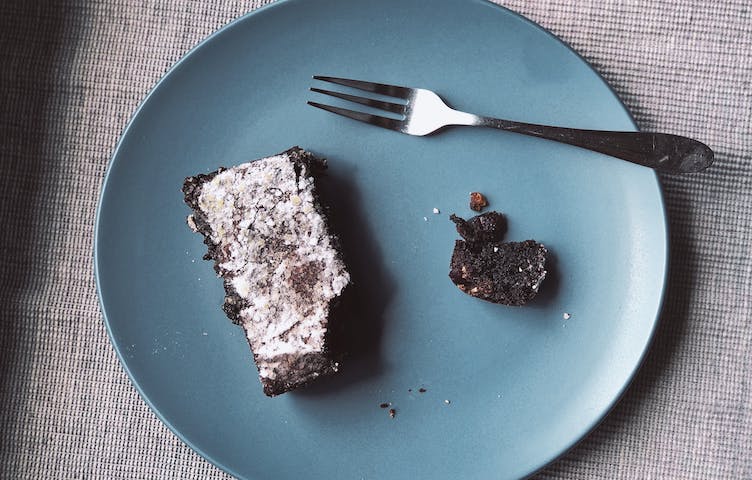
Dessert
The length of this elegant accessory is 16-17 cm. It is distinguished by a thin and narrow base with three prongs. Dessert utensils are served in fine restaurants, where they are placed above the plate. The small device is convenient for eating sweet foods, including:
- pies with fruit filling;
- cakes;
- cupcakes;
- sponge cakes;
- eclairs;
- pineapple slices;
- melon and watermelon balls.
During outdoor buffets, when sweets are eaten standing, you can use one dessert fork . At the table it is used in tandem with a dessert knife.
Fruity
The distinctive features of this product are a long thin handle and two sharp teeth. The length does not exceed 16.5 cm. The accessory is served in restaurants with fruits cut into slices such as pineapple, melon, papaya or small fruits - strawberries, grapes. For fruit salad with dressing, the two-pronged instrument is served along with a dessert spoon.
Additional forks
The required set for table setting includes nine cutlery for the first course, salad, main course and dessert. Among them, three forks are always served - dinner, salad, dessert. For larger receptions, additional accoutrements may be offered for special dishes with complex shapes or textures. These include different types of seafood, pasta, snails, fondue. If the menu includes these dishes, the utensils for them are placed to the left of the plate.
With two teeth
Crabs and shrimp are traditionally eaten using a short instrument with two small prongs . The narrow base allows you to penetrate into the cracks of the shells and extract tender meat. Crab forks are not often found in households; they are usually used in fish restaurants. In addition to the main purpose, they are used to serve cocktailsalates containing shrimp, olives, pickled onions and cherries.
A two-pronged instrument is fed to the snails. It is shorter and thinner than a seafood jig, and the teeth curve inward to make it easier to remove the snail from its shell. This accessory can be served with canapés and cold appetizers served in small portions.
In fine restaurants you can find the so-called “deli fork”. This serving piece with an elongated handle and two sharp teeth is used for only one product - thinly sliced Italian prosciutto ham.
There are also professional two-pronged tools that are used to cut cheese, separate meat, and mix pasta. But the table is not served with such products.
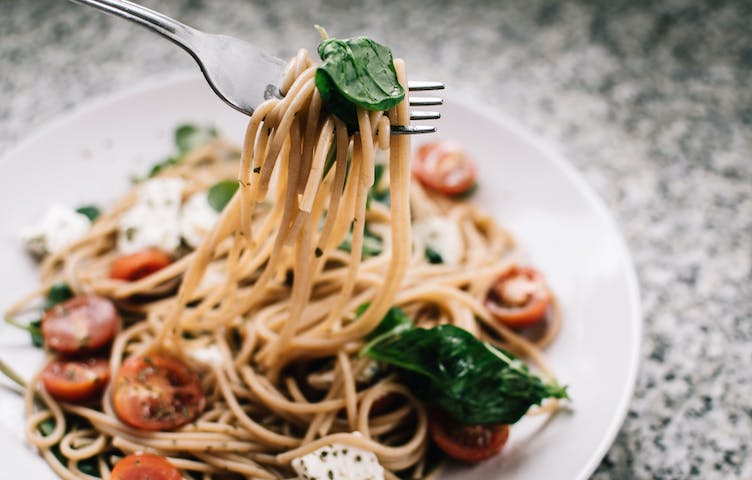
Three prong
Three-prong accessories are used for specific dishes and products, including:
spaghetti - the device for them is equipped with three long teeth with protrusions along the edges. This shape helps you roll long pasta faster. In addition to spaghetti, the utensil is suitable for other long pasta products - fettuccine, linguine, tagliatelle. It is more often found in Italian restaurants;
fondue - this dish should be served with a long metal instrument with a handle made of heat-resistant material. The base of the product is slightly curved, with three teeth set close to each other. This device is used to eat cheese and chocolate fondue; for the meat version, a two-pronged fork is used;
oysters - these shellfish are served with a special three-pronged device. It looks like a spoon with a flat head and three teeth - two wide on the sides and narrow in the center. This design allows you to remove the mollusk from the shell along with the liquid. You can also eat crabs and lobsters with an oyster fork;
ice cream - this dessert is usually eaten with a teaspoon. But in restaurants it is served with a special accessory that resembles a hybrid of a fork and a spoon. The wide base is equipped with three short figured teeth. The sharp edge can be used to break off hard pieces of treats, and the base can be used to scoop up softened ice cream.
A hundred years ago, most cutlery had three prongs, so this option predominates among antique utensils.
Materials for making forks
In the Middle Ages, when etiquette was the privilege of aristocrats, all serving items were made of silver and gold. But since the 18th century, tableware has spread everywhere. Ordinary people at that time used forks made of iron, wood and non-ferrous metals. Nowadays, the list of materials has been significantly expanded - it includes stainless steel, aluminum, plastic, and various metal alloys.
Steel cutlery
Chromium is added to stainless steel to provide corrosion protection and a beautiful shine. Steel utensils are not destroyed by moisture, high and low temperatures. They do not absorb foreign odors and are easy to clean with ordinary detergents. Due to its magnetic properties, steel utensils are suitable for washing in dishwashers with a magnetic system.
Serving items are also made from steel with the addition of chrome and nickel. This alloy has a soft silvery tint and is resistant to corrosion and acids. Steel appliances can be divided into three types:
- 18/10 - the most expensive and stable;
- 18/8 - average stability;
- 18/0 - budget, but poorly resistant to corrosion.
Chrome-nickel forks with silver plating
Applying a thin layer of silver increases the durability of the utensils and gives them partial antibacterial properties. Silver-plated devices look no less beautiful than products made from pure silver, but at the same time they are much lighter in weight and heat up more slowly. A layer of noble metal 15 microns thick lasts 25 years, 20 microns - up to 35 years. The 90 micron thick coating has a lifetime guarantee.
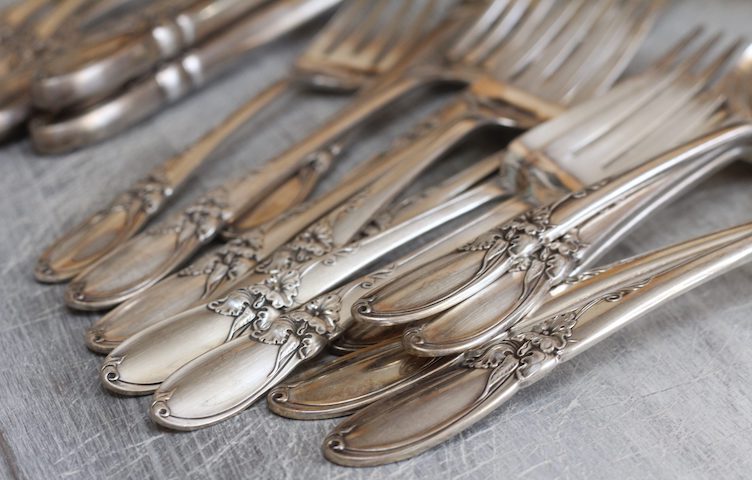
Silver
Silver tableware has a beautiful shine, softer than stainless steel. The noble metal does not rust and has antibacterial properties. The quality of products depends on the silver content, which can be determined by testing. Tableware is made from five types of material:
- 925 is the so-called high quality sterling silver;
- 916 - composition used for expensive serving sets;
- 960 - silver with high antibacterial properties;
- 875 is a silver alloy from which it is madeor utensils in pre-revolutionary Russia and the USSR;
- 800 is the cheapest type of material, with the addition of 20% copper.
The higher the standard, the softer the metal, which means that products made from it bend faster and get scratches.
Another noticeable drawback of silverware is the formation of patina. This dark coating forms on the surface over time, so silver items need to be cleaned regularly. In addition, silver conducts heat well, causing the forks to heat up quickly.
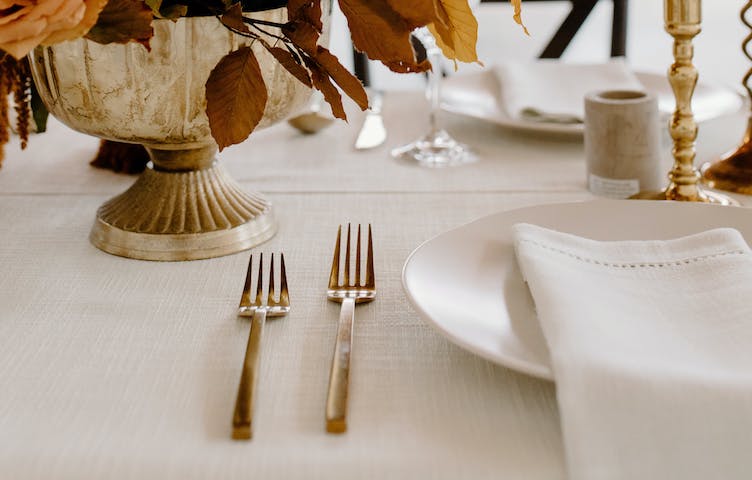
Gold plated
Gold plating on the surface of tableware performs two functions at once - it improves the appearance and increases the anti-corrosion properties. Appliances made of silver or stainless steel are usually gold-plated. The coating is usually made of 750 or 585 gold. The layer thickness ranges from 0.04 to 0.1 mm. The thicker the coating, the longer it lasts. Sometimes only fragments of the product, for example, the tip of a pen, are decorated with gilding.
Aluminum
Aluminum serving items are lightweight, smooth, and have a beautiful shine. They are easy to clean and inexpensive. But such utensils have many disadvantages - they quickly heat up, become deformed from physical influences, and become stained when in contact with sour food. In expensive restaurants, aluminum accessories are not used, as they look unsightly compared to steel and silver ones.
How to choose
Typically, forks are purchased as part of cutlery sets. Good accessories should be smooth, comfortable in the hand and pleasant in appearance. Pay attention to four more factors:
material - stainless steel is the leader in strength and ease of maintenance. A set of steel serving items with a beautiful design will be appropriate both at home and in a cafe or restaurant. If you want to create a family heirloom, choose silver plated or sterling silver accessories;
quality - make sure that the surface of the products is well polished and the inner sides of the teeth are not jagged;
number of items - sets can contain from 16 to 70 items. To begin with, it is enough to purchase a set for 4-6 people, a third of which is made up of forks;
design - the style of the utensils should be combined with the rest of the utensils, and in a restaurant - correspond to the concept of the establishment.
Ready-made sets contain only dinner forks. Other types of products, including dessert, fruit, fish, are purchased separately.
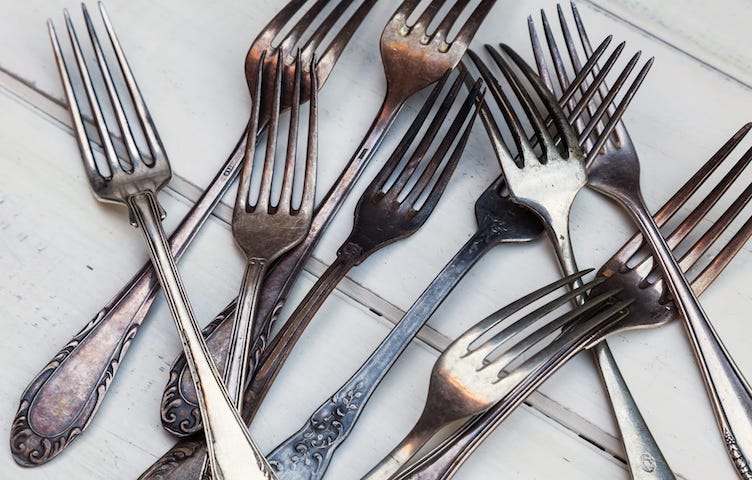
Cutlery care
Secrets to extending the life of cutlery:
- Remember to clean your cutlery immediately after use. If there is a delay, at least rinse them to prevent exposure to table acids.
- Check the condition of your dishwasher regularly. If necessary, contact a specialist to adjust it to the parameters of the water used, since the factory settings do not always match the characteristics of the water.
- Gradually reduce the amount of detergent and rinse aid used to the minimum required.
- Avoid contact of cutlery with iron and silverware.
- Remove cutlery from the dishwasher immediately after drying is complete (usually 15 minutes after the end of the wash cycle). Do not leave them in a car where the atmosphere is hot and humid.
- Never use aggressive detergents, even on 18/8 or 18/10 steel.
- If there are traces of detergent or food residue on your cutlery, be sure to rinse and dry it with a towel.
- To remove stains, use stainless steel cleaner or wipe with a cotton swab soaked in vinegar, then rinse and dry thoroughly.
















































/https%3A%2F%2Fcomplexbar.com%2Fimages%2Fblog%2F245%2Fvilki-na-stole-752x480.jpeg)
/https%3A%2F%2Fcomplexbar.com%2Fimages%2Fblog%2F245%2Fskov_glavn.jpeg)
/https%3A%2F%2Fcomplexbar.com%2Fimages%2Fblog%2F245%2Fhaiboli.jpg)
/https%3A%2F%2Fcomplexbar.com%2Fimages%2Fblog%2F245%2Fpymki.jpg)
/https%3A%2F%2Fcomplexbar.com%2Fimages%2Fblog%2F246%2F2024-04-09_17.22.54.jpg)
/https%3A%2F%2Fcomplexbar.com%2Fimages%2Fblog%2F246%2F2024-04-09_17.22.47.jpg)
/https%3A%2F%2Fcomplexbar.com%2Fimages%2Fblog%2F246%2FCODE_anons_foamydrops_752%D1%85480_eng.jpg)
/https%3A%2F%2Fcomplexbar.com%2Fimages%2Fblog%2F246%2FAlina_752%D1%85480_eng.jpg)
/https%3A%2F%2Fcomplexbar.com%2Fimages%2Fblog%2F246%2F2024-04-09_17.23.22.jpg)
/https%3A%2F%2Fcomplexbar.com%2Fimages%2Fblog%2F246%2F2024-04-09_17.23.28.jpg)
/https%3A%2F%2Fcomplexbar.com%2Fimages%2Fblog%2F246%2F2024-04-09_17.23.35.jpg)
/https%3A%2F%2Fcomplexbar.com%2Fimages%2Fblog%2F246%2Fdrinksome_752%D1%85480_eng.jpg)
/https%3A%2F%2Fcomplexbar.com%2Fimages%2Fblog%2F246%2Fnude_752%D1%85480_eng.jpg)
/https%3A%2F%2Fcomplexbar.com%2Fimages%2Fblog%2F246%2F752%D1%85480_eng__1_.jpg)
/https%3A%2F%2Fcomplexbar.com%2Fimages%2Fblog%2F246%2F752%D1%85480_eng.jpg)
/https%3A%2F%2Fcomplexbar.com%2Fimages%2Fblog%2F246%2FStudioRaw_752%D1%85480_eng.jpg)
/https%3A%2F%2Fcomplexbar.com%2Fimages%2Fblog%2F246%2FDoppio_tea_752%D1%85480_eng.jpg)
/https%3A%2F%2Fcomplexbar.com%2Fimages%2Fblog%2F246%2FTognana_Stars_Stripes_752%D1%85480_eng.jpg)
/https%3A%2F%2Fcomplexbar.com%2Fimages%2Fblog%2F246%2FRona_752%D1%85480_eng.jpg)
/https%3A%2F%2Fcomplexbar.com%2Fimages%2Fblog%2F246%2FDoppio_vending_752%D1%85480_eng.jpg)
/https%3A%2F%2Fcomplexbar.com%2Fimages%2Fblog%2F246%2FEssence_sukhie_smesi_752%D1%85480_eng.jpg)
/https%3A%2F%2Fcomplexbar.com%2Fimages%2Fblog%2F246%2FODK_sukhie_smesi752%D1%85480_eng.jpg)
/https%3A%2F%2Fcomplexbar.com%2Fimages%2Fblog%2F246%2Funiforma-barmena.jpg)
/https%3A%2F%2Fcomplexbar.com%2Fimages%2Fblog%2F246%2Fkak-nanyat-barmena.jpg)
/https%3A%2F%2Fcomplexbar.com%2Fimages%2Fblog%2F246%2Fsirop_scale_2400.jpeg)
/https%3A%2F%2Fcomplexbar.com%2Fimages%2Fblog%2F246%2FPeugeot_Anons_Paris_U%27Select_Line_Daman_752%D1%85480_eng.jpg)
/https%3A%2F%2Fcomplexbar.com%2Fimages%2Fblog%2F246%2Fkofe-vostochniy.jpg)
/https%3A%2F%2Fcomplexbar.com%2Fimages%2Fblog%2F246%2FMadler.jpg)
/https%3A%2F%2Fcomplexbar.com%2Fimages%2Fblog%2F246%2Fprofbartender_glavn.jpeg)